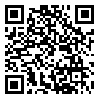Volume 69, Issue 1 (4 2011)
Tehran Univ Med J 2011, 69(1): 29-35 |
Back to browse issues page
Download citation:
BibTeX | RIS | EndNote | Medlars | ProCite | Reference Manager | RefWorks
Send citation to:



BibTeX | RIS | EndNote | Medlars | ProCite | Reference Manager | RefWorks
Send citation to:
AA B, M B M, L G, M G, M S, M F, et al . The preventive effects of posterior pericardiotomy on atrial fibrillation after elective coronary artery bypass grafting. Tehran Univ Med J 2011; 69 (1) :29-35
URL: http://tumj.tums.ac.ir/article-1-273-en.html
URL: http://tumj.tums.ac.ir/article-1-273-en.html
Bolourian AA 
 , Beheshti Monfared M
, Beheshti Monfared M 
 , Gachkar L
, Gachkar L 
 , Ghomeisi M
, Ghomeisi M 
 , Shahzamani M
, Shahzamani M 
 , Foroughi M
, Foroughi M 
 , Kazem Arabnia MK
, Kazem Arabnia MK 
 , Ghods K
, Ghods K 
 , Dabbagh A *
, Dabbagh A * 
 1
1

 , Beheshti Monfared M
, Beheshti Monfared M 
 , Gachkar L
, Gachkar L 
 , Ghomeisi M
, Ghomeisi M 
 , Shahzamani M
, Shahzamani M 
 , Foroughi M
, Foroughi M 
 , Kazem Arabnia MK
, Kazem Arabnia MK 
 , Ghods K
, Ghods K 
 , Dabbagh A *
, Dabbagh A * 
 1
1
1- , alidabbagh@yahoo.com
Abstract: (7070 Views)
Background: Atrial fibrillation is the most common but benign arrhythmia following cardiac surgery. Although this arrhythmia is often self-limited and vanishes in about 24 hours upon surgery a number of arrhythmias might ensue among which some might be really life-threatening. A multitude of therapeutic modalities have been proposed for the prevention of this arrhythmia and one of them is posterior pericardiotomy. This method has not been fully accepted by the peers yet and more studies are needed to prove its efficacy and benefits to the patients.
Methods: In this single-blind randomized clinical trial, done over a 2-year period from February 2009 to January 2011, the effects of posterior pericardiotomy were evaluated in 174 patients (87 the case and 87 the control groups) undergoing elective coronary artery bypass grafting (CABG). The case group underwent CABG with posterior pericardiotomy while the control group underwent CABG-only operation. The postoperative incidence of arrhythmia, especially atrial fibrillation, was assessed for a week using statistical methods.
Results: The prevalence of postoperative atrial fibrillations were fewer in the group undergoing CABG with posterior pericardiotomy compared with the CABG-only group (P<0.004).
Conclusion: Posterior pericardiotomy seems to reduce the incidence of atrial fibrillation following elective CABG therefore, its application is suggested for elective
CABGs
Send email to the article author
| Rights and permissions | |
 |
This work is licensed under a Creative Commons Attribution-NonCommercial 4.0 International License. |



